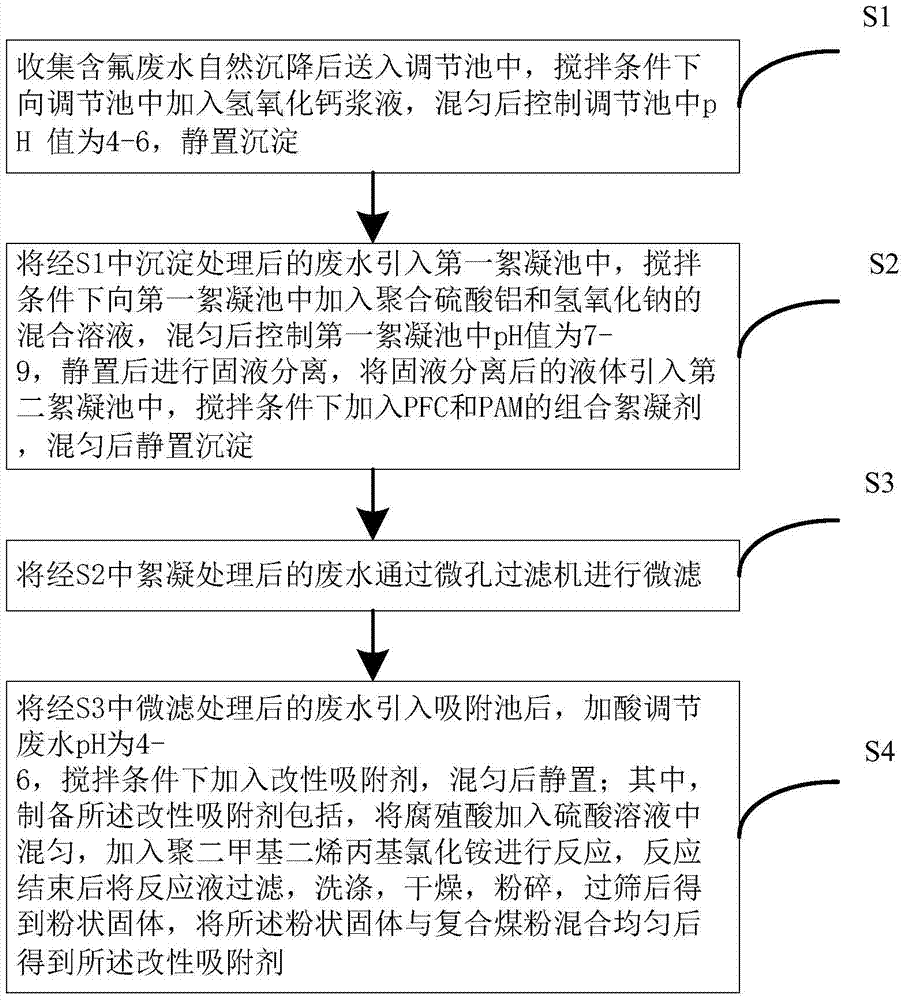A treatment process for high fluorine-containing wastewater in fluorine chemical industry
A waste water treatment and chemical technology, applied in the direction of water/sewage multi-stage treatment, water/sludge/sewage treatment, water pollutants, etc., can solve the problems of difficult separation and regeneration of adsorbent, small specific gravity, high moisture content of sludge, etc. , to achieve fast adsorption and desorption rates, mild regeneration conditions, and large adsorption capacity
- Summary
- Abstract
- Description
- Claims
- Application Information
AI Technical Summary
Problems solved by technology
Method used
Image
Examples
Embodiment 1
[0034] A kind of high fluorine-containing wastewater treatment process of fluorine chemical industry proposed in this embodiment comprises the following steps:
[0035] S1. Sedimentation: collect fluorine-containing wastewater and settle naturally for 5 hours, then send it to the regulating tank, add calcium hydroxide slurry with a concentration of 15wt% to the regulating tank at a rate of 1.5m / min under stirring conditions, and control the regulating tank after mixing The pH value is 4-5, and it is left to settle for 8 hours;
[0036] S2. Flocculation: introduce the wastewater treated by precipitation in S1 into the first flocculation tank, and add polyaluminum sulfate and hydrogen in a weight ratio of 4:1 to the first flocculation tank at a rate of 0.1 m / min under stirring conditions The mixed solution of sodium oxide, after mixing, control the pH value in the first flocculation tank to 7-8, and carry out solid-liquid separation after standing for 1 hour, introduce the liqui...
Embodiment 2
[0040] A kind of high fluorine-containing wastewater treatment process of fluorine chemical industry proposed in this embodiment comprises the following steps:
[0041] S1. Sedimentation: Collect fluorine-containing waste water to settle naturally for 8 hours and then send it to the regulating tank. Add calcium hydroxide slurry with a concentration of 20wt% to the regulating tank at a rate of 0.5m / min under stirring conditions, and control it in the regulating tank after mixing. The pH value is 5-6, and it is left to settle for 6 hours;
[0042] S2. Flocculation: introduce the wastewater treated by precipitation in S1 into the first flocculation tank, and add polyaluminum sulfate and hydrogen in a weight ratio of 1:1 to the first flocculation tank at a rate of 0.5 m / min under stirring conditions A mixed solution of sodium oxide, after mixing, control the pH value in the first flocculation tank to 8-9, and carry out solid-liquid separation after standing for 3 hours, introduce ...
Embodiment 3
[0046] A kind of high fluorine-containing wastewater treatment process of fluorine chemical industry proposed in this embodiment comprises the following steps:
[0047] S1. Sedimentation: Collect fluorine-containing waste water to settle naturally for 6 hours and send it to the regulating tank. Add calcium hydroxide slurry with a concentration of 17wt% to the regulating tank at a rate of 1.2m / min under stirring conditions, and control the regulating tank after mixing. The pH value is 5-6, and it is left to settle for 7 hours;
[0048] S2. Flocculation: introduce the wastewater treated by precipitation in S1 into the first flocculation tank, and add polyaluminum sulfate and hydrogen with a weight ratio of 3:1 to the first flocculation tank at a rate of 0.3 m / min under stirring conditions The mixed solution of sodium oxide, after mixing, control the pH value in the first flocculation tank to 8-9, and carry out solid-liquid separation after standing for 2 hours, introduce the liq...
PUM
 Login to View More
Login to View More Abstract
Description
Claims
Application Information
 Login to View More
Login to View More - Generate Ideas
- Intellectual Property
- Life Sciences
- Materials
- Tech Scout
- Unparalleled Data Quality
- Higher Quality Content
- 60% Fewer Hallucinations
Browse by: Latest US Patents, China's latest patents, Technical Efficacy Thesaurus, Application Domain, Technology Topic, Popular Technical Reports.
© 2025 PatSnap. All rights reserved.Legal|Privacy policy|Modern Slavery Act Transparency Statement|Sitemap|About US| Contact US: help@patsnap.com

